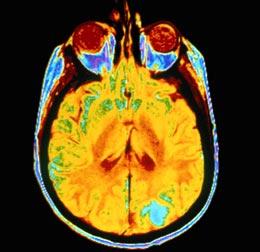New strategy could help beat tenacious brain tumours.
 Brain cancers could be treated by targeting the viruses that often lurk within.Getty
Brain cancers could be treated by targeting the viruses that often lurk within.GettyCancer experts have suggested a new way to tackle particularly tenacious brain tumours known as glioblastomas. Attacking a common virus often found in these cancers may halt their growth, say researchers.
This technique might provide an alternative to current surgical treatments for glioblastoma, which, because of the tumours' position deep in the brain, carry a significant risk of brain damage.
This strategy may help doctors pursue their preferred tactic of allowing the body's own immune system to attack cancer cells, systematically eradicating them from the brain tissue without harming nearby healthy cells.
Until now it has been impossible for the immune system to distinguish brain tumour cells from healthy cells as they often have the same identifying marker proteins - called antigens - and because brain tumours often suppress immune function.
Delaying tactics
In the new study, oncologist Duane Mitchell at Duke University Medical Center and colleagues build on previous research showing the consistent presence of cytomegalovirus, a type of herpesvirus, in glioblastoma cells but not in surrounding healthy tissue.
Roughly 50-80% of healthy people in the United States are infected with cytomegalovirus, although in healthy people it remains latent. Virus particles multiply to high numbers only in those with compromised immune systems. So Mitchell and his team wondered if they could halt the cancer by guiding the immune system to attack the unique antigens of the virus in glioblastoma cells.
The team took white blood cells from 21 patients, exposed them to parts of the virus, and injected the cells back into the patients. Their preliminary results suggest that this technique is safe and effective.
“Because the immune system kills both the virus and the cell it resides in, we are hoping that we will be able use this vaccine to kill the tumour cells that standard therapy can't reach,” explains Mitchell.
Mitchell and his colleagues will unveil their findings1 on 1 June at a meeting of the American Society of Clinical Oncology in Chicago. Although the results are preliminary, tumour progression for those in the trial was delayed by more than a year on average - and several patients had no sign of tumour growth after two years.
The delay in tumour growth using standard therapy is typically six to eight months compared with non-treatment, with average survival of less than 15 months.
Attack is the best form of defence
Nobody is certain whether the virus triggers the cancer or the cancer attracts the virus. But, “the fact that the brain tumour cells create an immunosuppressive environment where the virus can make its home makes a lot of sense,” explains Charles Cobbs at California Pacific Medical Center Research Institute in San Francisco, who first discovered the association between cytomegalovirus and the tumours.
If the virus is causing the cancer, then destroying it is all the more important. But even if it merely exists side by side with the cancer, “its unique antigens look like the perfect way for the immune system to go about attacking the tumour,” explains Cobbs.



No comments:
Post a Comment